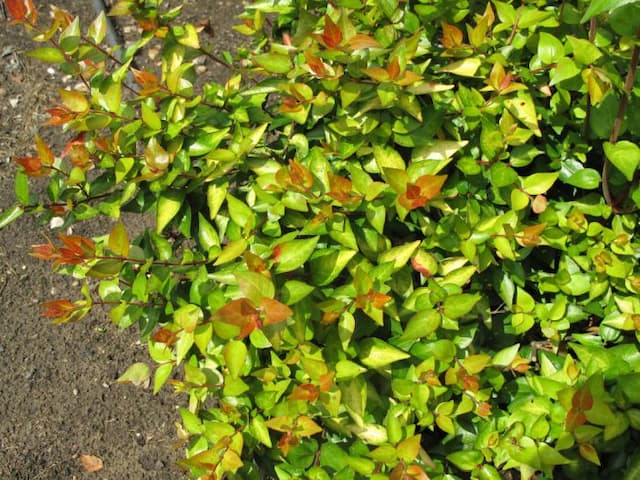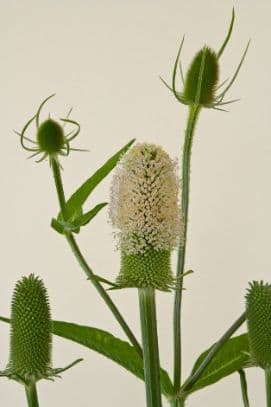Weigela Weigela 'Mont-blanc'

ABOUT
Weigela 'Mont-blanc' is a striking ornamental shrub that features a profusion of blooms along with lush foliage. During its flowering season, the plant is adorned with trumpet-shaped flowers that boast a pure white coloration, which contrasts beautifully against the greenery. The blooms appear in clusters, adding to the visual impact of the shrub, attracting pollinators such as hummingbirds to the garden. The leaves of Weigela 'Mont-blanc' are oval-shaped with a slightly serrated edge and emerge in a medium to dark green hue that may acquire purplish tones as the seasons change. This combination of elegant flowers and vibrant foliage lends the Weigela 'Mont-blanc' to be a cherished addition to any landscape, providing both visual appeal and ecological benefits.
About this plant
 Names
NamesFamily
Caprifoliaceae
Synonyms
Mont Blanc Weigela
Common names
Weigela 'Mont-blanc'.
 Toxicity
ToxicityTo humans
Weigela is not generally considered toxic to humans. There are no well-documented cases of poisoning from ingesting parts of the Weigela plant, and it is not known to have toxic properties that would cause adverse health effects in humans. However, like with any plant, individual allergic reactions are possible, and it is always advisable to avoid eating plants that are not known to be edible.
To pets
Weigela is also not generally considered toxic to pets. It is not listed as a poisonous plant for animals such as dogs and cats, and there are no well-documented cases of pet poisoning from this plant. While pets should not be encouraged to eat ornamental plants, ingestion of Weigela is unlikely to result in more than mild gastrointestinal upset, if any symptoms occur at all. If you suspect your pet has ingested a large quantity of any plant and is displaying signs of distress, consult a veterinarian.
 Characteristics
CharacteristicsLife cycle
Perennials
Foliage type
Deciduous
Color of leaves
Green
Flower color
White
Height
6 feet (1.8 meters)
Spread
5 feet (1.5 meters)
Plant type
Shrub
Hardiness zones
5
Native area
Asia
Benefits
 General Benefits
General Benefits- Ornamental Appeal: Weigela 'Mont-blanc' produces an abundance of white flowers, adding a striking visual interest to gardens and landscapes.
- Attracts Wildlife: The trumpet-shaped flowers are a magnet for hummingbirds and beneficial pollinators such as bees.
- Low Maintenance: This plant is known for being easy to care for, requiring minimal pruning and being relatively drought tolerant once established.
- Seasonal Interest: It provides a long blooming period that typically lasts from late spring into early summer, contributing to extended garden color.
- Versatility in Landscaping: Can be used in a variety of landscape applications including borders, hedges, foundation plantings, or as a focal point.
- Deciduous Foliage: The plant's leaves provide autumn color as they change through the season before falling off, adding another layer of interest to the garden.
 Medical Properties
Medical PropertiesThis plant is not used for medical purposes.
 Air-purifying Qualities
Air-purifying QualitiesThis plant is not specifically known for air purifying qualities.
 Other Uses
Other Uses- Living Fence: Weigela can be planted in a row to create an attractive, dense living fence that provides privacy and defines property lines.
- Natural Mulch: Fallen weigela leaves can be collected and used as mulch to enrich soil nutrients and retain moisture in garden beds.
- Wildlife Shelter: The dense foliage of weigela provides excellent shelter and nesting opportunities for birds and other small wildlife.
- Photography Backdrop: With its lovely blooms, weigela makes for a stunning backdrop for outdoor photography, especially in spring when flowers are in full bloom.
- Erosion Control: Weigela's root system can help stabilize soil on slopes and prevent erosion.
- Educational Resource: Schools and educational institutions can use weigela plants to teach students about plant growth, reproduction, and pollination.
- Artistic Reference: Artists can use weigela flowers and foliage as a real-life reference for botanical illustrations and paintings.
- Sound Barrier: A thick hedge of weigela can help reduce noise pollution from streets and neighbors when planted along property perimeters.
- Winter Interest: Even after leaves drop, the architectural structure of weigela's branches can add visual interest to a winter landscape.
- Theme Gardens: Weigela can be included in a 'white garden' theme, where all plants feature white blooms or foliage, creating a tranquil and cohesive aesthetic.
Interesting Facts
 Feng Shui
Feng ShuiWeigela is not used in Feng Shui practice.
 Zodiac Sign Compitability
Zodiac Sign CompitabilityWeigela is not used in astrology practice.
 Plant Symbolism
Plant Symbolism- Gratitude: Weigela plants are often associated with gratitude due to their abundant, recurrent blooms that can be seen as nature's way of showing thanks.
- Enduring Love: The long-lasting nature of the Weigela's flowers symbolizes a love that endures through time.
- Prosperity: With its full, plush growth, Weigela 'Mont-blanc' signifies prosperity and growth, implying flourishing in various aspects of life.
- Romantic Attraction: The trumpeted shape of the flowers suggests a declaration of affection or attraction, often used in romantic contexts.
 Water
WaterWeigela 'Mont-blanc', commonly known as Weigela, should be watered deeply, ensuring that the water reaches the roots, about once a week. During the growing season and in the absence of rainfall, increase watering to twice a week. Each watering session should provide the Weigela with about 1 to 1.5 gallons of water, depending on the size of the plant and the soil's moisture level. In the hot summer months, monitor the soil more frequently and water as needed to maintain consistent moisture without waterlogging the plant. During the dormant season, reduce watering to every other week or less, based on the soil dryness and weather conditions.
 Light
LightWeigela prefers a spot with full sun to partial shade for optimal growth and flowering. It thrives when it receives at least 6 hours of direct sunlight per day, although in regions with very hot summers, some afternoon shade can help prevent stress. Avoid placing Weigela in deep shade, as this can result in fewer flowers and a leggy growth habit.
 Temperature
TemperatureWeigela prefers a temperate climate and is hardy in a range from -20 to -30 degrees Fahrenheit. Its ideal growing temperatures range between 50 and 75 degrees Fahrenheit during the active growing season. Weigela can survive temperature spikes above this range, but sustained heat may stress the plant, and extra watering might be necessary.
 Pruning
PruningPrune Weigela immediately after it finishes blooming, which is typically in late spring to early summer, to shape the plant and remove any dead or crossing branches. This timing allows the plant to form new buds for the next year's flowers. Pruning is also essential to encourage bushier growth and maintain the plant's size. Annually prune about one-third of the oldest stems to keep the Weigela rejuvenated and healthy.
 Cleaning
CleaningAs needed
 Soil
SoilWeigela flourishes in well-draining soil enriched with organic matter, preferring a slightly acidic to neutral pH between 5.5 and 7.5. A mix of loamy soil, compost, and a handful of peat moss or pine bark can be ideal for optimizing growth conditions.
 Repotting
RepottingWeigelas are typically outdoor plants and do not require regular repotting. If Weigela 'Mont-blanc' is kept in a pot, repot every 2-3 years to refresh the soil and provide room for growth.
 Humidity & Misting
Humidity & MistingWeigela 'Mont-blanc' is adaptable to various humidity levels and prefers average outdoor conditions, without the need for specific humidity adjustments.
 Suitable locations
Suitable locationsIndoor
Grow Weigela in bright light, ensuring moderate watering.
Outdoor
Plant in sun to part-shade, water regularly, and mulch.
Hardiness zone
4-8 USDA
 Life cycle
Life cycleThe Weigela 'Mont-blanc', also known as Weigela florida 'Mont-blanc', begins its life cycle when seeds germinate in moist, well-drained soil during the spring. Seedlings emerge and develop into young shrubs with a rapid growth rate, often needing several years to reach maturity. Upon maturity, the Weigela 'Mont-blanc' displays its characteristic lush, white flowers in late spring to early summer, attracting pollinators like bees and hummingbirds. After pollination, the plant sets small capsules of seed that mature by late summer to early fall, then disperse to start a new generation. Throughout the growing season, Weigela 'Mont-blanc' continues to produce new leaves, and with proper pruning after flowering, can encourage a second bloom. In winter, the plant enters a period of dormancy, conserving energy and resources until the arrival of the following spring where the cycle begins anew.
 Propogation
PropogationPropogation time
Spring-Early Summer
The Weigela 'Mont-blanc', commonly known as Weigela, can be propagated by taking softwood cuttings in late spring or early summer when the plant's growth is most vigorous. The most popular method involves choosing healthy, non-flowering shoots and cutting them into sections about 4 to 6 inches (10 to 15 cm) long. After snipping just below a leaf node, the bottom leaves are removed and the cut end is dipped into a rooting hormone to encourage root growth. The prepared cutting is then planted in a pot filled with a well-draining soil mixture, with about half the length of the cutting inserted into the soil. To retain humidity, the pot can be covered with a plastic bag or placed in a propagator. Within a few weeks, roots should start to develop, after which the new Weigela plants can be acclimatized to outdoor conditions and eventually transplanted to their final position in the garden.








